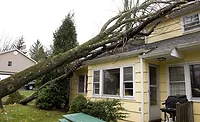Storm Season 2025
UPDATE: May's Severe Storms Lash U.S. Roofs with Tornadoes, Hail and High Winds
Anticipated blooms have been eclipsed by extreme weather, featuring rain, hail and tornadoes, causing chaos across regions of the country

One daring storm chaser, foxalbiazul on YouTube, caught this EF3 tornado just north of Miner, Mo., a city in Scott County in the southeastern part of the state near St. Louis, as it was heading toward Interstate 55 near Blodgett on Friday, May 16.
— Image courtesy of YouTube
This article was last updated on May 21, 2025 at 15:21 to reflect current events.
Despite the classic rhyme promising May flowers after April showers, a relentless parade of severe weather — from an EF3 tornado in St. Louis on May 16 to widespread damage across the Gulf Coast — has battered roofs across multiple U.S. regions this month.
Roofers in Kentucky and Missouri are repairing thousands of damaged homes after tornadoes killed at least 21 people and ripped off some 5,000 roofs. In the Upper Midwest, EF2 tornadoes and baseball-size hail shredded shingles in Wisconsin and Michigan over the weekend of May 17–18.
A separate EF2 tornado ripped through the Florida Panhandle earlier this month, leaving dozens of homes with roof and structural damage.
These and other events have capped a spring season that has already outpaced historical norms for hail days and insured convective-storm losses — trends that roofing professionals continue to contend with through resilient materials, enhanced construction techniques and coordination with insurers.
RELATED | Underwriters Take Surprising Lead on Funding for FORTIFIED Roofs
Great Plains
Since the weekend of May 17–18, the unrelenting severe-weather pattern escalated into a major tornado outbreak across the central United States.
From May 18 to May 20, more than 52 tornadoes — several rated EF3 and EF4 — ripped through Kansas, Missouri, Oklahoma and Arkansas, producing straight-line winds over 100 mph and hail chunks exceeding softball size.
According to NOAA’s Storm Prediction Center, the outbreak injured at least 38 people and left over 600,000 customers without power.
In Pratt County, Kansas, an EF3 twister derailed rail cars and flattened barns, while in Williamson County, Ill., an EF4 storm tore through dozens of homes — injuring seven residents and closing a section of Interstate 57 for debris removal.
Northeast
As the central U.S. begins to catch its breath, the East Coast is girding for an exceptionally late nor’easter — only the third May event of its kind since 1990.
The low-pressure system is scheduled to crawl up the Mid-Atlantic on May 21 before intensifying off New England.
The National Weather Service is forecasting 1–3 inches of rain and wind gusts up to 60 mph along coastal Massachusetts and Cape Cod, with flood watches stretching from southwestern Pennsylvania through Maryland and Virginia.
Interior New England could see March-like highs not exceeding 50 °F, and higher elevations in Vermont and New Hampshire may even pick up a dusting of wet snow—a nearly unheard-of late-spring twist, according to the Associated Press.
Midwest
St. Louis Mayor Cara Spencer warned residents of “more severe weather ahead” on Sunday as the city continued recovery from a late-May 16 EF3 tornado that displaced families and shredded roofs across multiple neighborhoods, according to Reuters.
Spencer estimated more than $1 billion in property damage — including thousands of homes with missing shingles or collapsed roofs — and urged homeowners to secure loose roofing materials before the next storm arrives.
Ahead of the latest damage in St. Louis proper, an unstable spring system spawned multiple tornadoes across the Ohio River Valley. In Scott and St. Louis counties, EF3 winds of up to 155 mph ripped roofs off an estimated 5,000 properties and injured at least 38 people; five fatalities were confirmed in the city and two more in Scott County.
Local reports indicate Kentucky bore the brunt of the outbreak, with an EF2–EF3 tornado in Laurel County killing nine residents and flattening entire blocks of mobile homes and farm buildings. Statewide, Kentucky officials said at least 14 people died.
Across both states, insurance adjusters have reported a surge in roof-repair claims, as homeowners seek quick repairs for wind-damaged shingles and torn underlayment.
On May 15–16, the National Weather Service reported spring supercells raking Minnesota, Wisconsin and Michigan, with hail up to four inches in diameter — large enough to punch holes in asphalt shingles — and several EF2 tornadoes in Wisconsin’s St. Croix and Dodge counties.
Wisconsin’s Juneau and Dodge counties also reported wind-whipped debris and fallen trees that tore through roofs, with homeowners filing claims for missing shingles and punctured metal panels.
Further east, the NWS reported straight-line winds of 75–80 mph that snapped trees into roofs in Livingston County, Michigan, with scattered damage in the Detroit metro area and Chicagoland suburbs. Local crews logged hundreds of service calls for leak mitigation and emergency tarping.
Tornado Rips Through Florida Panhandle
Earlier this month, a parent supercell rolled ashore on the Gulf Coast, spawning an EF2 tornado that carved a destructive path through Holmes and Okaloosa counties in the Florida Panhandle.
NWS surveys noted torn-off porch awnings and major roof damage on several homes, with dozens of calls to roofing contractors for tarp-over services as hail and straight-line winds battered outbuildings and detached garages.
Skyline Roofing Contractors, posting on Instagram, reminded residents that the company was available for emergency roofing services and emphasizing their readiness to assist.

Comparison to Historical Storm Trends
NOAA data show that U.S. hail days (storms producing at least two inches of hail) have averaged 121 days per season over the past two decades; in 2024 alone, there were 133 such days, signaling an uptick in hail frequency and geographic reach beyond classic Tornado Alley.
Meanwhile, a 2023 study by the Insurance Information Institute found U.S. insured losses from severe convective storms topped $50 billion through September, the traditional end of storm season — exceeding any prior record for thunderstorm-related claims.
Reinsurers Munich Re and Swiss Re reported that global insured losses from severe thunderstorms in 2023 reached $60 billion — roughly three-quarters of all weather-related payouts — underscoring the growing financial toll on insurers and homeowners.
The roofing industry has been under strain from ballooning claims and increases in material costs, particularly over the past 90 days, as tariffs and economic uncertainty undermine supply chains and the broader economy.
State Farm said average repair costs per claim have climbed by about $2,000 since 2021–22, due mainly to raw-material inflation, increased severe weather and a tight labor market. Roofing Contractor has reported that insurers are responding by tightening underwriting, requiring higher deductibles and offering discounts for impact-rated roofing.
Contractors report that carriers increasingly limit reimbursement to actual cash value on roofs older than 10 years, squeezing contractor margins when tear-off and disposal fees exceed allowances, according to the Insurance Institute for Business & Home Safety.
As violent weather increases in frequency, a new report by the Alabama Department of Insurance from the Center for Risk and Insurance Research (ACIIR), found FORTIFIED homes were more than 70% less likely to have an insurance claim than a typically built home.
Looking for a reprint of this article?
From high-res PDFs to custom plaques, order your copy today!







